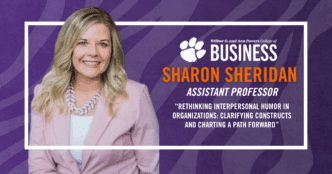In the workplace, humor can be a valuable commodity. Humor can lighten the mood, ease stress or tensions and even build stronger connections. But what makes humor effective in the workplace, especially in leadership roles?
That’s the question that Sharon Sheridan, assistant professor of management at the Wilbur O. and Ann Powers College of Business, and co-authors Cecily Cooper, professor at Miami Herbert Business School, and Dejun Tony Kong, professor at the University of Colorado Boulder’s Leeds School of Business, set out to find. Their study, “Rethinking Interpersonal Humour in Organizations: Clarifying Constructs and Charting A Path Forward”, challenges the way organizational scholars have historically measured humor and offers a new framework that could reshape how researchers and leaders can think about laughter at work.
“Much of the existing research on humor comes from personality psychology, which looks at how someone’s style of humor affects their own well-being,” Sheridan said. “But when you move humor into an organizational setting, it’s not just about the individual anymore, it’s about how others interpret and respond to it. Those are very different things.”
Beyond “humor styles”
Past studies often grouped workplace humor into four main “styles”: affiliative (building rapport), self-enhancing (coping with stress), self-defeating (putting yourself down) and aggressive (putting others down).
However, the research team found that these categories didn’t take key factors into consideration that were important. These factors included the intent behind the joke, the content itself and the audience’s reaction.
“Someone’s motive for telling a joke, the way it comes across and how people respond are all distinct,” Sheridan explains. “But the existing measures mixed them up, which created a lot of problems.”
To test this, the team collected data from over 1,000 working adults across various industries. They found evidence that showed leaders’ humor was most effective not because of a particular style, but because of how their intentions and concern for employees were perceived. In other words, whether leaders joked to build relationships, cope with stress or show they did not take themselves too seriously, the effect on employees was similarly positive.
This research opens new questions about the role of context and intent. Sheridan’s work shows that workplace humor is most effective when employees feel their leaders genuinely care about them. It’s less about telling the perfect joke and more about the message behind it and how leaders show support, give guidance and create a positive environment. She plans to continue exploring how different workplaces shape how humor is received.
“Ultimately, we hope this helps the field move forward with stronger tools and better questions,” said Sheridan. “Our work provides scholars with a clearer framework to study humor. By separating intent, content and audience reaction, we can start asking the right questions and building a foundation for future studies in organizational behavior.








